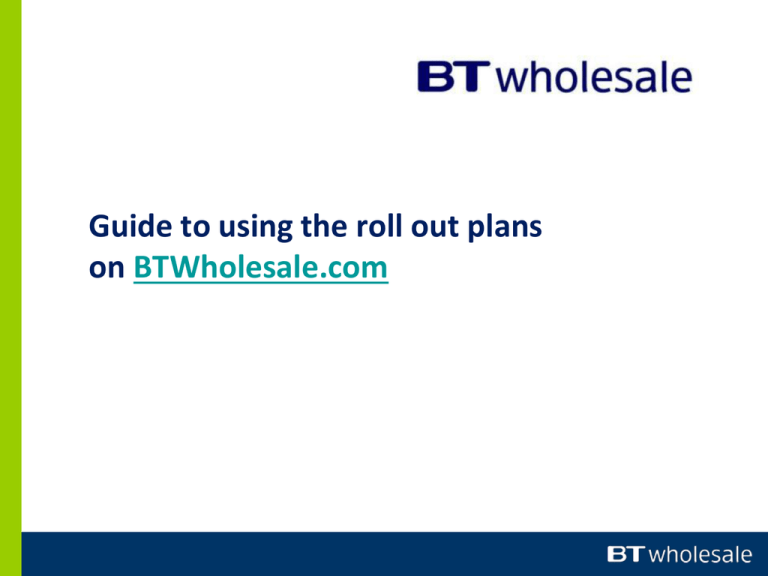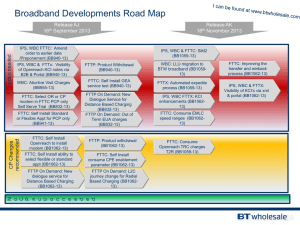
Guide to using the roll out plans
on BTWholesale.com
Legal and Confidentiality Statement
The information contained in this Presentation is confidential information as per your terms and conditions with British
Telecommunications plc (BT). Please treat it accordingly and do not forward, republish or permit unauthorized access. The
information contained in this Presentation represents BT Wholesale’s current thinking for the intended WBC FTTP product at the
time this Presentation was developed and may be subject to change. In relation to the WBC FTTP product referred to in this
Presentation which are currently under development and/or trial, BT gives no undertaking or other commitment that it will be
made commercially available in the same form.
Any price indications and time scales contained within this Presentation are estimates for discussion purposes only and do not
constitute any contractual or other obligation. All prices/charges are shown exclusive of value added tax and any other
applicable duties and taxes which will be added to invoices.
BT reserves the right to make changes to the information in this Presentation at any time without further notice.
Any developments carried out by CPs based on the contents of this Presentation are entirely at the CP’s own risk.
Note “BT” and “BT Wholesale” are trademarks of British Telecommunications plc.
© British Telecommunications plc, 2011. All rights reserved.
British Telecommunications plc
Registered Office: 81 Newgate Street London EC1A 7AJ
Registered in England no.1800000
Marketing Fibre Broadband
As the fibre footprint continues to expand CP’s are finding it increasingly important to know exactly
how many of their customers and potential customers are within a fibre enabled area, this slide-deck
serves as a guide for how to best accomplish this.
There are a number of different scenarios in which you might wish to understand fibre availability,
these are a few of the more common ones:
Selling/marketing fibre broadband into your existing customer base – In this scenario a ‘bulk
check’ of your existing customer is probably most appropriate & will check your existing users
against current availability & availability planned within the next 6 months:
https://www.btwholesale.com/pages/sc/static/broadband/Community/Broadband_Community/
Coverage/Bulk_checker.html
Defined opportunities (specific group of companies or geography) – In this scenario you may
wish to refine your search by a group of exchanges or a number of different postcodes, the
following slides will help you do that.
Speculative marketing/selling - In this scenario you may wish to refine your search looking at
future availability, again the following slides will help you do that.
Marketing at Exchange Level
Marketing at an exchange level is a useful way of getting your message/proposition out to all
customers within an enabled exchange area & could be used to encourage potential customers to
contact you for you to assess whether they can have service via the Broad Band Availability Checker.
Typically we see CP’s sending out a generic mailer when marketing at an exchange level i.e. “your
exchange is/due to be fibre enabled, please contact us on XYZ number where we’ll confirm if you can
take service”
Its also useful for forward marketing as above with the opportunity to collect a ‘waiting list’
You may wish to further refine your marketing by using the Postcode level data (see later slides) on
conjunction with this exercise
Marketing at Exchange Level
Marketing at an exchange level
Go-to ‘Latest FTTC Exchange and Cab Availability’
Select the “FTTC rollout update” which will take you to
Openreach Where and When site.
Where there are 3 sets of data, see below for choices
Exchanges coming soon
Exchanges already accepting
orders (PDF +Excel Formats)
This is the list of exchanges that
are currently enabled for fibre
therefore can be marketed as
‘available for FTTC now’
Future exchanges
This is the list of exchanges that
are planned for future fibre
enablement & have a forecasted
enablement date.
Therefore you can market prior to,
or post the forecasted enablement
dates.
This is the list of exchanges that
are planned for future fibre
enablement but don’t have a
forecasted enablement date
therefore can be cautiously
forward ‘marketed’
Marketing at Post Code Level
Marketing at an Postcode level provides a greater degree of accuracy than marketing at an exchange
level as you can be far more specific about whether your customer can take service
There are two ‘routes’ when assessing availability at a Postcode (& cabinet level) the following slides
will explain both options
To ascertain postcode level information it is useful to be familiar with what the data is illustrating, the
final slides explain how to interpret & use the postcode data
Marketing at Post Code Level
(for currently enabled cabinets)
Go-to ‘Latest FTTC Exchange and
Cab Availability’, and open the file
‘FTTC Cab Delivery Update
Summary’
Status
RFS Date
Cab No
Exchange
SAUID
RFS
02/06/2011.
1
ABINGDON
SMAI
This file lists all of the currently enabled cabinets in
all of the currently enabled exchanges & gives a
date when that cabinet was enabled e.g.
Then … go to ‘Latest FTTC Exchange
and Cab Availability’, and open the
file ‘PCP to Postcode Report’
Marketing by
enabled cabinets
Percent
SAU_ID
Name
Postcode SAU_NODE_ID Lines
SMAI ABINGDON OX14 2BL
{SMAI}{p1}
100%
SMAI ABINGDON OX14 2BH {SMAI}{p1}
100%
SMAI ABINGDON OX14 2BB {SMAI}{p1}
60%
FTTC or
FTTP
FTTC
FTTC
FTTC
Use this file to then ‘market’ to premises that are live within
the enabled cabinets.
For further help in interpreting this data, click here?
Marketing at Post Code Level
(for cabinets to be enabled in the future)
Go-to the Openreach ‘Where &
When’ and choose either the
‘exchanges coming soon’ or future
exchanges file.
Exchanges Coming Soon
- Lists exchanges to be enabled within the next 6 months
- Indicates forecasted Ready For Service date
- Identifies if this is FTTC and/or FTTP deployment
Future Exchanges
- Lists exchanges to be enabled later than 6 months
- Indicates forecasted Ready For Service date
- Identifies if this is FTTC and/or FTTP deployment
Then go to ‘Latest FTTC Exchange
and Cab Availability’, and open the
file ‘PCP to Postcode Report ’
Knowing your intended exchange and RFS date, you can
use the PCP to postcode to identify which cabinets and
postcodes will be fibre enabled in the future
Forwarding
Postcode
Marketing
Once you have determined which of the future
exchanges you wish to ‘market’ (and note its RFS date)
you can then use the PCP to postcode report to
ascertain which of the cabinets & postcodes within that
exchange will be enabled for fibre & then forward
market from the exchange RFS date
For further help in interpreting this data, click here?
How to use the Postcode & PCP sheet
Postcodes do not match PCP’s (cabinets) and a single cabinet could serve multiple postcodes in full or
part i.e. a single cabinet (cab 1) could serve 100% of postcode RM12 1AA but only 20% of postcode
RM12 1AB with the remaining 80% of postcode RM12 1AB being served by another cabinet(s) (i.e. cab
5)
The postcode sheet doesn’t show RFS availability but can be used in conjunction with the current
exchange data & cabinet data to determine current RFS availability or with future exchange RFS dates
to derive a tentative RFS date
How to use the PCP to postcode report
Latest FTTC Exchange and Cab Availability
SAU_ID
Name
Postcode SAU_NODE_ID
Exchange
Only Flag
CLNEW NEW CROSS SE15 2BU {CLNEW}{p63}
Exchange
(1141) Code
0
Not used/not
meaningful
Exchange
Name
A postcode
served by this
cabinet (63)
This is the PCP
(cabinet) number
(cabinet 63)
Percent
FTTC or
Uplift Phase Deployed
Lines
FTTP
52%
2.67
4b
Yes
Indicates whether
‘cab’ is FTTC or
FTTP enabled
Not used/not
meaningful
This is the % of lines in
this postcode served by
this cabinet, so in this
example 52% , the
remaining 48% will be
served by a different
cabinet(s)
FTTC
Key:
“YES” = Part of scheduled
deployment
“NO” = Removed or
Deferred from Scheduled
Deployment
“Blanks” = Not part of a
phase / untargeted
cabinet
Phase deployed
How to use the PCP to postcode report
Latest FTTC Exchange and Cab Availability
SAU_ID
Name
SMAI
SMAI
SMAI
SMAI
ABINGDON
ABINGDON
ABINGDON
ABINGDON
Postcode SAU_NODE_ID
OX14 2BL
OX14 2BH
OX14 2BB
OX14 2BB
{SMAI}{p1}
{SMAI}{p1}
{SMAI}{p1}
{SMAI}{p5}
Exchange Percent
FTTC or
Uplift Phase Deployed
Only Flag
Lines
FTTP
0
100%
3.65
5a
Yes
FTTC
0
100%
3.65
5a
Yes
FTTC
0
60%
3.65
5a
Yes
FTTC
0
39%
4.63
5a
Yes
FTTC
So in this example we show:
• The exchange is Abingdon
• A sample of 3 different postcodes
• The Cabinet is 1
• The cabinets are enabled for FTTC & where enabled in phase 5a
Of the 3 postcodes that are served by this cabinet:
• 2 of the 3 postcodes have 100% coverage, i.e. all telephone lines in OX14 2BL are served by cabinet 1
• However 1 of the 3 (OX14 2BB) is split between cabinets 1 & 5, meaning 60% of all telephone lines
in OX14 2BB are served by cabinet 1 BUT 39% of all telephone lines in OX14 2BB are served by
cabinet 5. Fortunately both of these cabinets are enabled for FTTC however there will be some
instances where this isn’t the case which will obviously make ‘marketing’ at postcode level less
accurate.
It should be noted that % will not always = 100%, as such the % should be used as an indication only






